Tree of life: alternatives
to traditional burials
Modern funeral options that respect both the deceased and the environment
By Carmen J. Michaud
Updated October 14, 2022
Walking thru Mount Royal Park and the two cemeteries that border it, one appreciates that this large green area – almost 1000 acres – provides oxygen to the city. These acres of trees are its lungs.
We must be thankful that this large expanse cannot be destroyed, or “developed.”
I have wondered if there was some way of becoming part of this living thing. Not a name on a headstone but a living, breathing part.
A few years ago, I found an article about a company in Italy that was developing a pod in which a body would be enclosed and provide the nourishment for a growing tree. The body would be placed in an “egg” in a fetal position and the roots of the tree would surround it. I wondered if this was truly possible, if there are other versions, and when this would be available.
The first company I had heard of trying this, Capsula Mundi, is the brainchild of two designers, Anna Citelli and Raoul Bretzel. Their tag line is “Life Never Stops.”
Capsula Mundi – Anna Citelli and Luca Mari
You first exhibited your pods, Capsula Mundi, in 2003 in Milan at the Salone del Mobili. How did this idea come about?
In a culture far removed from nature, overloaded with objects for the needs of daily life and focused on youth, death is often dealt with as a taboo. We believe that this unavoidable passage, so meaningful, is not the end but the beginning of a way back to nature.
Inspired by these reflections, we decided to redesign the coffin – an object entirely left out of the design world – using ecological materials, and universal life symbols, such as the egg, the fetal position, and the tree.
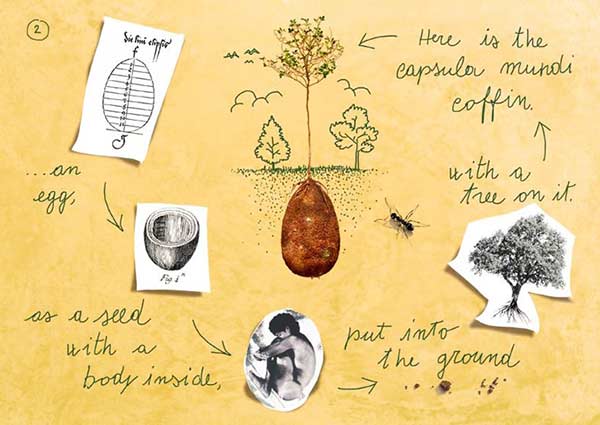
Capsula Mundi concept – Image: courtesy of Capsula Mundi
And you imagine forests of these trees everywhere?
These trees will mark the place of a person. A place of peace. Only a tree, a symbol of the connection between the sky and the earth, will mark the resting place of the deceased. As tree after tree is planted, the cemetery will become a forest, free of the architectural motifs that mark today’s memorial grounds. The cemetery will be transformed into a place of nature, one where families can stroll and learn about the natural world, where communities will come together to tend and care for trees. In short, it will become a sacred forest.
How do you see this helping our environment?
Presently, to make a coffin, a tree must be cut down. The coffin has a short life cycle and a strong environmental impact. A tree takes between ten and forty years to reach maturity, and the coffin is of use for just three days! We want to plant trees instead of cutting them down! Furthermore, Capsula Mundi urns are made from biodegradable material and come from seasonal plants.
So, for the moment, you are selling only the urns, which can be attached to a tree and would contain the ashes?
The Capsula Mundi urn is biodegradable. The ashes are put in through a hole, closed with a cone-shaped screw top. After the burial, a tree, chosen in life by the deceased and in consideration of the local ecosystem, will be planted on top of it. The Capsula Mundi urn connects the ashes to a tree.
Capsula Mundi urns are made in Italy. Each urn is unique thanks to handcrafted interventions during production.
And the body pods? Where are you in terms of making these available?
Capsula Mundi for the body is still in the start-up phase. This kind of burial is legal in many countries but not everywhere. In Italy, where this project was born, only the Capsula Mundi urn is permitted. However, “green cemeteries” are popular in many other countries, especially English-speaking ones. Our team has been working to raise awareness and promote the idea, fully convinced that before changing laws, we need to challenge the way people think.
‘Let children walk with Nature, let them see the beautiful blendings and communions of death and life, their joyous inseparable unity, as taught in woods and meadows, plains and mountains and streams of our blessed star, and they will learn that death is stingless indeed, and as beautiful as life.’
– John Muir
Bios Urn – Annie Lewis
What was the impetus to develop the Bios Urn?
The idea for the Bios Urn came to Spanish founder Gerard Moline when he was a young child. He was in the garden planting flowers and vegetables with his grandmother when she discovered a dead bird. She instinctively took the bird, buried it in a hole and planted some wildflower seeds on top – thus giving it new life.
Gerard carried this memory with him for many years and in 1997, he created the prototypes for the Bios Urn, which later went to market in 2001.
It was a new sustainable invention that went on to win various design accolades. In 2013, Gerard launched an internet start-up company to market the Bios Urn online, and more importantly worldwide, to change how people face the end of their lives in a very traditional and conservative sector.
Are you the first to market this “plant-based” burial?
The Bios Urn was the world’s first biodegradable urn in the marketplace and also the only one that introduced the idea of planting a tree with the remains obtained after cremation. In 2002, the Bios Urn went on to be a winner of the ADI FAD design awards and in 2005, it was nominated as a finalist for the INDEX Award with a “design to improve life.” During this time, one of the very first Bios Urns produced was used by the Barcelona Zoo to plant the remains of an iconic albino gorilla known as Little Snowflake and turn him into an African tree.
While the design has changed over the past decade, the core focus of Bios Urn has remained the same – to add meaning to this process of life and return to nature.
Ashes have a very high PH level that can impede plant growth. How is this averted with the Bios Urn?
The Bios Urn contains different biodegradable components. The main source of the Bios Urn body and capsule is recycled paper and cardboard. The moulding system does not contain any type of glue or additives, which allows the creation of big-size pieces.
Every one of our urns includes a soil expansion disc. This small compact disc expands tenfold in size when watered. It absorbs water to keep the roots moist and allows for a constant supply of nutrients. These components are beneficial for all plant life, are made of natural materials, and excel in maintaining the water level and soil balance. All materials are locally sourced. It is also produced ethically, something very important to us.
With regards to the high PH level, as you rightly point out, ashes have a certain PH level that can harm fresh seeds or a seedling if they are exposed to them in the root, before acclimating to the soil.
The Bios Urn has a special patented design and comes in two unique compartments. One compartment holds the ash specifically, while the other holds the soil mix, and seeds/baby sapling. The patented double-component design was created with the specific intent of housing the seeds or a seedling safely, to ensure healthy growth. In between the double capsule lies the expansion disc that includes nutrients to aid in the growth of the tree. Ash PH levels can only harm seeds if they are grown directly in them, as seeds require suitable soil to grow.
The amount of ashes placed in the urn will not upset the delicate nutrient balance required for the growth of plants. Generally, you can safely spread twenty pounds of ash per thousand square feet of garden. It should also be stated that scattering ashes in a woodland area, or placing them in the sea, has around the same effects on the surrounding environment as planting them – the only difference between scattering and using a Bios Urn is that, over time, a tree grows, which in the long run is more conducive to the environment.
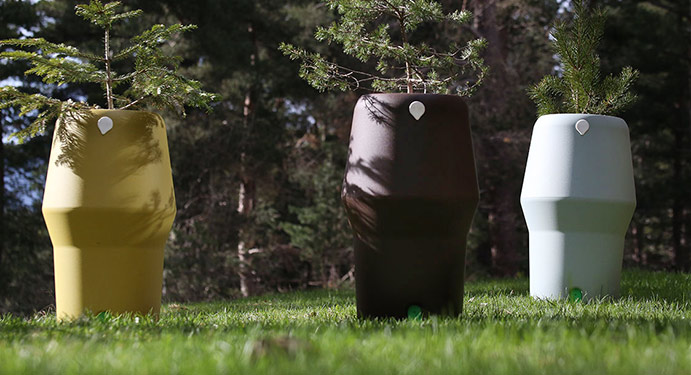
Bios Urns – Image: courtesy of Bios Urn
The Bios Urn is sold with a tree of choice. Do you ship to Canada?
Urne Bios is the French entity of the Bios Urn. It is the same company and brand, simply a different name for a French-speaking market. We ship many Urne Bios all over Canada and work with different distributors and retailers there.
We made the decision to not sell the tree add-on, unless someone asks for this. We didn’t want people to feel limited. You see, the Bios Urn works with every single kind of seed or seedling. No exceptions! Everyone should choose a tree that is meaningful to them and their loved ones. Fruit trees, flowering trees, evergreens or conifers are all completely compatible. You can also elect to use a seedling, or sprout instead of a seed.
We always encourage people to choose a native or common tree species for the place they will plant the urn since this is more respectful of the environment and ensures better tree growth. This is extremely important to us. We don’t want to disrupt the natural flora by planting trees not suitable or not found in the area. So we offer tree species guides per region and country, all around the world.
For anyone who reaches out and would like tree seeds included with their Urn, we include them free of charge.
Are there restrictions state-to-state, province-to-province, as to what can be and where it can be buried?
The laws and regulations relating to the burial or the scattering of ashes change from province to province. Many don’t actually specify if it is legal or not to plant a biodegradable urn that turns a person into a tree. The laws have not evolved as quickly as the marketplace.
North America is one of the most advanced places in the world in terms of modern funeral options and planting locations, which is a big plus. The company, founded in Spain, will ship to every single country, with no exceptions! So far, we have shipped to 47 countries on five continents and counting.
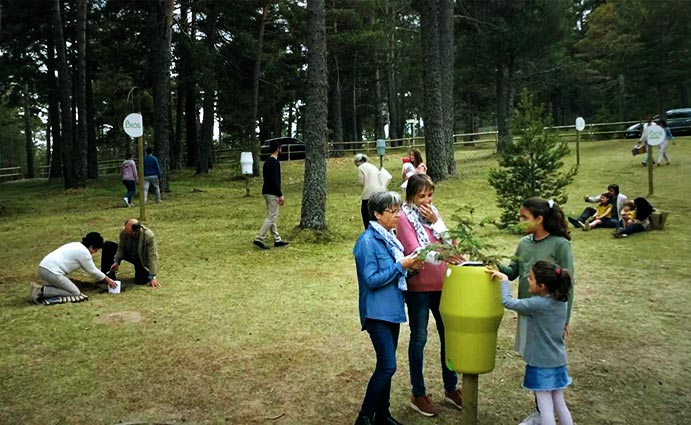
Bios Park – Image: courtesy of Bios Urn
Our very first Bios Park, a green area where our biodegradable urns are planted, is in Quebec, near Montreal! This is an initiative we hope to expand in the future around the world.
Can someone purchase only the Bios Urn in anticipation? How long will it be viable?
Many people order the Bios Urn for themselves, pre-planning their end-of-life wishes. . The Bios Urn does not have an expiration date. Thanks to the materials used to create it, you can keep the urn indefinitely. It can be safely stored for years or even decades, even with ashes stored inside. The urn only begins to break down once it’s planted and exposed to moisture.
And then someone can add the tree?
If planting the urn at a later date, we simply recommend acquiring the seeds, seedling or young tree at the time of planting.
Do you recommend that someone interested in the Bios Urn contact a funeral home for guidance?
Most people will already be dealing with a funeral home to arrange the cremation. If the family already has the Bios Urn before the funeral, it can be filled by the crematorium directly. Those who order the Bios Urn after the funeral, the destination chosen, can place the ashes inside the urn themselves. We wanted to make things as simple as possible for families.
Some funeral homes offer guidance on possible planting locations and local rules and regulations, which is very helpful.
‘Trees are sanctuaries. Whoever knows how to speak to them, whoever knows how to listen to them, can learn the truth. They do not preach learning and precepts, they preach, undeterred by particulars, the ancient law of life.’
– Herman Hesse, Baume: Betrachtungen und Gedichte
Living Urn USA – Steve H.
What was the impetus to develop the Living Urn?
The Living Urn was founded by three childhood friends who grew up in Southern California and later relocated to Colorado. The idea was inspired by a tree-planting memorial in honour of a friend’s father who passed while they were in elementary school. The trio later reunited, remembering back to the time of the tree planting and thought, “Why not take it a step further and incorporate the cremated remains of a loved one with the tree?”
After two years of working closely with expert soil scientists, arborists, material engineers and funeral directors, The Living Urn was born in 2015.
Following the success of The Living Urn, the founders expanded their offering by launching additional unique eco-friendly urns. All of these products are highly functional, attractive, and made using only eco-friendly materials and production processes.
What do you offer to the consumer as a “plant-based” burial?
The Living Urn is the first and only biodegradable urn and planting system designed to be planted in combination with a living tree and the only all-in-one system that comes with everything a family needs to plant an enduring tree memorial. We have been issued two strong utility patents for our invention.
The Living Urn, this all-natural system, includes a special biodegradable urn made from recycled plant materials, a soil additive called RootProtect that serves to counter certain properties of cremated remains that can make the growing environment harsh on a young tree, and aged wood chips for mulching. The system is packaged in an urn case made from bamboo, a sustainable resource. The Living Urn offers a tailored menu of tree options for every zip code throughout the U.S. and most postal codes in Canada to ensure people only plant trees well suited for their geographic region (over 30 beautiful options for most areas).
Ashes have a very high PH level that can impede plant growth. How is this averted with the Living Urn?
The all-natural Living Urn system includes a special biodegradable urn made from recycled plant materials using only water, pressure and heat (no glues or chemicals!). This special urn biodegrades at an accelerated rate when planted so the roots can grow freely and establish the tree at the planting site.
The Living Urn is the only biodegradable urn and planting system designed to be used with young trees, and not seeds. This was a critical part of the design as it can be a challenge to grow a tree from a seed.
How it works is simple – cremated remains are placed at the bottom of the biodegradable urn and RootProtect is added on top. The young tree is then planted in combination with the urn. Wood chips (mulch) are added around the tree to help keep the soil moist and insulated from temperature changes.
The Living Urn is sold with a tree of choice. Do you ship to Canada?
Yes, we ship Living Urns and trees to Canada every day. We also work with approximately 500 funeral home partners in Canada and more than 3,500 funeral homes in the U.S.
Are there restrictions state-to-state, province-to-province, as to what can be and where it can be buried?
Many of our customers will simply plant The Living Urn on their own property or in their yard. Some customers will go out and plant their tree in a favourite place or at a local cemetery, or on Church properties. Some people have asked and received permission to plant in City, State and even National parks.
Can someone purchase only the Living Urn in anticipation? And then someone can add the tree?
We understand the interest in taking care of plans ahead of time and this is the reason why we developed our Pre-Planning program. With this program, we send The Living Urn system to the family along with a voucher for a tree that can be redeemed at any time. The Living Urn has no expiration so it can be stored as long as needed.
Do you recommend that someone interested in The Living Urn contact a funeral home for guidance?
Families can contact our funeral home partners for more information or contact us directly and we would be happy to help.
Interesting that you are on Quebec Street… Synchronicity!
A great coincidence! Plus we love Quebec and Canada!
Plantation Arbre de vie – Claude and Joanne Cloutier
What was the impetus to be involved in “plant-based” internment? Your website states there are forty acres available. Were these purchased with this in mind?
We love the feeling of serenity when we are with nature and in the forest. The idea only came to mind after seeing all the work involved in the upkeep of our forest. Our clients come to plant a tree in our forest in their loved one’s memory. We plant trees. The client plants the ashes. It’s a way of reconnecting a deceased person’s spirit with nature and a symbol of continuity.
Do you plant bio-urns from any recognized supplier at Plantation Arbre de Vie?
Yes. Anyone can come and pick a spot that is suitable for the species of tree they want to plant. We only provide the spot and upkeep.
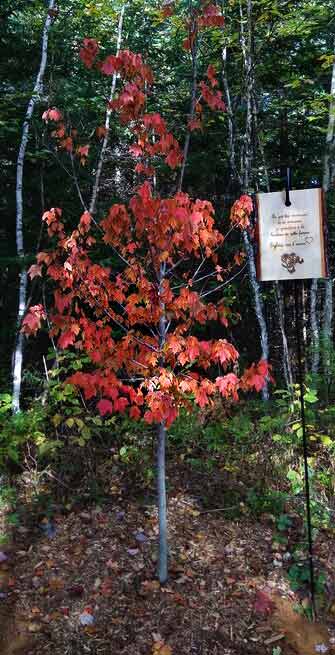
Maple tree at Plantation Arbre de Vie – Image: courtesy of Plantation Arbre de Vie
Is there a time of year when this cannot be done?
Planting can only be done after the ground thaws till it starts to freeze, about mid-May through the end of October.
And what happens in that case?
Outside that timeframe, the ashes are best kept at the client’s home, or if the tree is already in a pot, water appropriately.
Did you require a special license to plant remains in Quebec?
We plant trees. The ashes act as a fertilizer for the tree. The laws are clear, once cremated, a person’s ashes belong to the succession. If buried on public property, permission must be obtained from the municipality. Since our property is private, there are no restrictions.
Were the groves naturally occurring? For example, Conifer Trail was already inhabited by evergreens, or did you decide on the planting design?
The forest was naturally selecting what type of trees grew in certain areas. Some areas are more softwood-oriented, with evergreens. Other areas have more hardwoods. The forest has a canvas. We just have to see it. As Michelangelo said, “The sculpture is already complete within the marble block before I start my work. It is already there. I just have to chisel away the superfluous material.”
The cost of the planting covers what length of time?
The life of the tree.
What happens in the case of the demise of the tree through disease or other?
We constantly monitor the forest. We would advise our clients of any damage and find a mutual solution. Planting another tree, for instance. The forest is a living legacy that we wish to leave behind. Our heirs agree with our wishes.
When might people visit the trees? Is there some time when you are not open?
We are only open during planting season. All visits to the property are upon reservation. The forest is only open between mid-May and the end of October, weather permitting. Sometimes, we may be away, so visits are restricted to our presence at the property. We wouldn’t want anyone to get lost.
‘I frequently tramped eight or ten miles through the deepest snow to keep an appointment with a beech tree, or a yellow birch, or an old acquaintance among the pines.’
– Henry David Thoreau
Notre-Dame-des-Neiges Cemetery – Ashley Ornawka
After many years of walking the grounds of Notre-Dame-des-Neiges, I do not recall noticing the Remembrance Grove. How long has this been operating?
Remembrance Grove is a fairly recent endeavour and has been operational since 2021.
How many trees of remembering have been planted to date?
Around 35 trees have been planted to date, but the land can host thousands of trees.
How do you identify the person associated with the tree?
Each tree is numbered, and the deceased’s name appears on a central monument located within Remembrance Grove. There is a small plaque wrapped around the tree base identifying each tree, which is placed over a protective sheath surrounding the bark itself.
You offer approximately nine species of trees. How were these selected?
The tree species vary according to what is available every season. We try to offer our clients a selection between six and nine species, including the Maple Tree.
I believe the Maple would be my choice… all the lovely changing colours! Was there a process for getting a license or approval from Environment Canada?
No authorization or license is necessary.
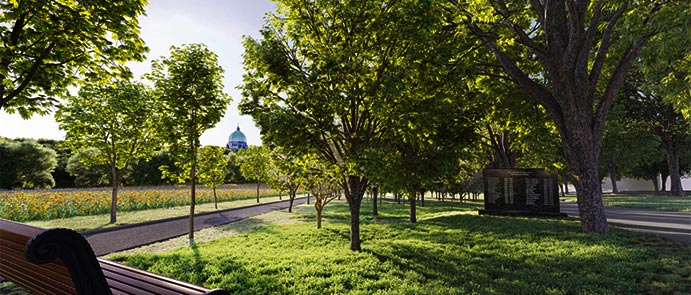
Remembrance Grove – Image: courtesy of Notre-Dame-des- Neiges cemetery
How long will these trees be viable? Is there a contract of time? What happens if the tree is diseased or destroyed?
Each tree lives approximately between one hundred to two hundred years. The tree is guaranteed for life and is replanted if ever it becomes sick or dies.
Are there plans to expand the grove?
A new grove has been added, named St-Louis’ Grove, which overlooks Lake St-Louis, west of Montreal.
Remembrance Grove is closer to the main entrance of Notre Dame Cemetery, with a beautiful view of St-Joseph’s Oratory. The latter will have thousands of trees as it is very large, whereas St-Louis will have bigger trees in a smaller area. Every part of the cemetery has a different signature concept. No two areas are the same.
Are there many cemeteries offering this option?
Other natural burial sites in Quebec can be found in Granby and Shawinigan. We are, however, the first eco-burial site located within a major city in Canada.
So this is a growing endeavour on the part of Notre Dame cemetery?
Our cemetery is very geared toward a green plan. Phases 1 and 2 of Remembrance Grove measure approximately 15 000 square feet, and there are well over 165 000 square feet left for the rest of its development for the years to come. We will keep going in this direction to favour Montreal’s ecosystem and biodiversity.
cimetierenotredamedesneiges.ca
‘A nation that destroys its soils destroys itself. Forests are the lungs of our land, purifying the air and giving fresh strength to our people.’
– Franklin D. Roosevelt
Shortly after learning more about these “eco-burials”, there was an article in The Guardian on September 2, 2022 about the demise of trees in the world. This gives even more impetus to consider becoming a tree. Our loved ones may find a quiet place to remember us, to commune with nature. And we can add oxygen to the planet, habitat for wildlife and beauty in the world.
Feature image: courtesy of Capsula Mundi

Other articles by Carmen Michaud
Other recent articles

Carmen J. Michaud is a creative and driven professional, with extensive experience in the fashion and design industry. Her career includes freelance consulting, advising on design, marketing, and sustainability, and engaging in creative projects. Carmen likes to write (and paint) and is majoring in Curiosity.

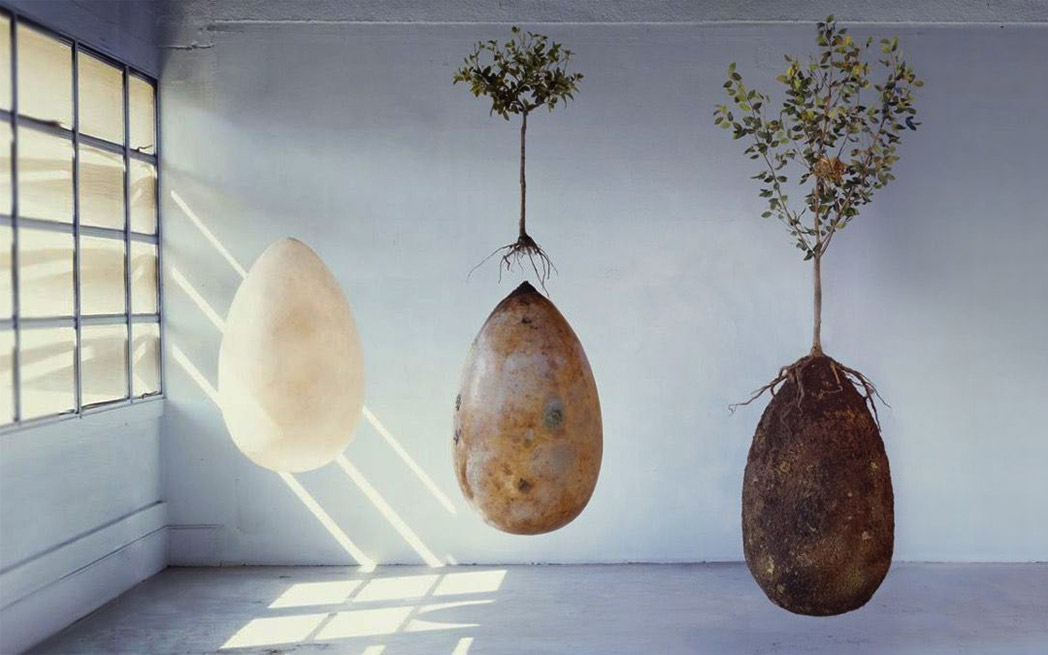
There are no comments
Add yours